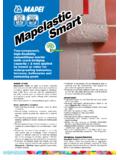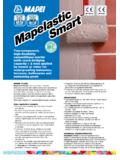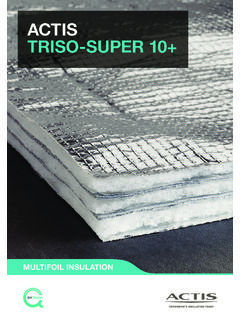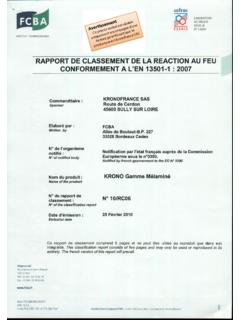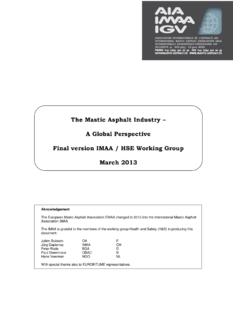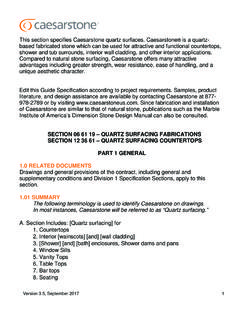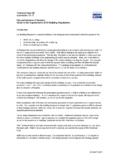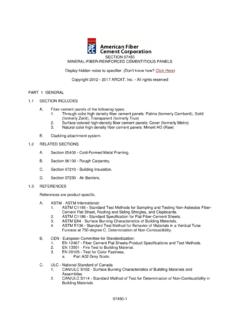Transcription of LA.P.I. Laboratorio Prevenzione Incendi SpA
1 NNOOTTIIFFIIEEDDTTEESSTTIINNGGLLAABBOORR AATTOORRYYIINNAACCCCOORRDDAANNCCEETTOOEE UURROOPPEEAANNDDIIRREECCTTIIVVEEFFOORRBB UUIILLDDIINNGGPPRROODDUUCCTTSS8899//1100 66 Laboratorio Prevenzione Incendi SpAEN 1363 Fire resistance tests Part 1 : General requirements Part 2 : Alternative and additional procedures General This Information book summarises the basic features of the above EN test especially those which are different from existing national procedures. The objective of determining fire resistance is to evaluate the behaviour of a specific element of construction when subjected to defined heating and pressure conditions which may be encountered in a fully developed fire. Fire resistance is the property of a composite construction, because no component can be fire resisting in its own right. Fire resistance examines how a structure resists fire and not how the individual materials react.
2 In a fire resistance test a representative sample of the element is exposed to a specified regime of heating and pressure in a furnace and the performance of the test specimen is monitored on the basis of defined criteria. Fire resistance of the test element is expressed as the time for which the appropriate criteria have been satisfied. EN 1363-1 contains the information related to the science and methodology of fire resistance testing. Where aspects and procedures of testing are common to any product type then they are specified in this test method. Where a general principle is common to many specific test methods, but the detail varies according to the element being tested the measurement of unexposed face temperature, then the principle is given in this document, but the detail is given in the specific test method. Where certain aspects of testing are unique to a specific test method, then no details are included in EN 1363-1.
3 Test equipment The furnaces that are currently used for fire resistance tests are controlled by means of plate thermometers. This has been introduced to harmonise thermal exposure between furnaces of widely differing designs across the EU. Heating regimeThe heating regime is unchanged from that used currently the standard temperature time curve given in ISO 834. T = 345 log10 (8t + 1) + 20 0200400600800100012000102030405060708090 100 110 120 130 140 150 160 170 180 Time [min]Temperature[ C]T = 345 log10 (8t + 1) + 20 EN 1634-1 Fire resistance testing of doors and shutters General This part is to be read in conjunction with the previous EN 1363-1 that covers the general requirements for fire resistance tests. This test is applicable to fire doors installed in vertical separating elements. Doors tested to this standard may be suitable for certain lift landing door applications.
4 Harmonised product standards are being developed within CEN/TC33 for fire doors and these, together with EN1634-1, will be used as a basis for CE marking of fire doors across the EU. It is proposed that these product standards will include mechanical conditioning requirements to be met prior to the fire test. These procedures are still to be agreed, so whilst tests to EN 1634-1 can be carried out, they cannot be used for future claims of compliance in support of CE marking if the correct mechanical conditioning tests have not been carried out. Further parts of EN 1634 are publishing for smoke control doors and for fire door hardware. Test conditions The standard temperature and pressure conditions given in EN 1363-1 are used. Preparation and installation of specimens The test specimens are installed as in practice. Particular attention is paid to the door leaf perimeter clearance gaps, for which a typical range is to be stated by the sponsor.
5 The tested gaps are set between the mid point and the maximum of the stated range. Fire doors need to undergo mechanical conditioning prior to testing. When designing the test specimen and selecting the supporting construction the need to obtain the maximum information for the field of direct application has to borne in mind. There is a choice between a standard supporting construction or an associated construction. Specification details of standard supporting constructions (both flexible and rigid types) are provided in EN 1363-1. An associated construction is a proprietary system in which the door will be installed in practice. Where compliance with the insulation criteria (I) is required, unexposed surface thermocouples are attached as described in EN 1634-1. If a door is of an uninsulated construction no unexposed face temperature measurements are required.
6 Where requested by the sponsor the specimen may be evaluated against the supplementary procedures for maximum temperature rise, required in some countries, in which case additional unexposed face surface thermocouples are positioned as described in EN 1634-1. Test procedure Before starting the test the door leaf clearance gap and retention forces door closer forces are measured. Observations are made throughout the test for evaluating integrity and insulation. Mandatory deflection measurements are made to record any significant distortions > 3mm to provide information relevant for the evaluation of the extended field of application. Performance criteria The specimen is monitored throughout the test for performance against the following criteria: Integrity (E) Insulation (I) and where required Radiation (W)The permissible classes, given in EN 13501-2 which can be used across Europe are given in the table below.
7 National Regulations in the various member states may not choose all of the options so it is important to check which are applicable before planning a test. criteria time (mins) E15 20 30 45 60 90 120 180 240 EI 15 20 30 45 60 90 120 180 240 EW 20 30 60 FIELD OF DIRECT APPLICATION OF THE RESULTS FOR THE SPECIMEN EVALUATED The field of direct application of the result has been made to control the changes that may be applied on the specimen evaluated in fire resistance test.
8 The kind of door must be the same of that one evaluated. Number of door leaf and technical characteristic must not be changed. Specific limitation for material and manufacture: wooden manufacture: the thickness of door leaf may increase but not decrease thickness and specific weight may increase but the weight must not rise the 25% the section and specific weight of frame may increase steel manufacture: frame size may increase to let bigger door leaf take place number of reinforcing elements for not insulated doors and number and kind of fixings of those elements to the frame may increase proportional to the size increase. glass manufacture: kind of glass and fixing technique must not change number and size of glass openings may decrease distance and position of glass openings must not change. Ornamental finish: if painting does not contribute to fire resistance of the door than any kind of paint are acceptable.
9 If it contributes such as intumescing paint than any change is not allowed. Ornamental laminated: ornamental laminated and wooden veneer of mm maximum may be applied on door leaf but not on the edges on normal doors that satisfied the insulation criteria. ornamental laminated and wooden veneer applied on not wooden door leaf and that one with thickness bigger than mm must be tested as part of the specimen. Changes in size: Doors with different size of those one tested are allowed but the variation depends on kind of product and time in which criteria were satisfied. To know which changes are allowed or not we need to know many information about the door. To let change in size be possible gap size must be fixed between average and maximum gap For any further information please contact us:Tel. +39 0574 575320 Fax. +39 0574 575323
